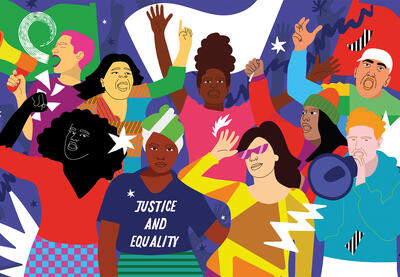“Many are out of practice at coming together, committing to one another in pursuit of a shared purpose, deliberating together, deciding together, and acting together – the essential practices of democracy.” – Marshall Ganz
Our democracy’s strength, or more plainly, the freedom for each of us to shape our lives, rests on our ability to collectively commit to one another for a shared purpose that centers our humanity. When we no longer live in this interdependence, understanding that our liberation is bound together, our collective power is divided and our democracy is weakened.
We increase our power to foster change when we are in community with one another – deliberating, deciding and taking action. Being intentional about how we are in community together begins our practice of democracy. In his book People, Power, Change: Organizing for Democratic Renewal, Marshall Ganz warns that many people are “out of practice at coming together.” Ganz further explains that we strengthen our democracy through practice.
The decline in democratic practice prompted the SPLC’s Learning for Justice program to shift to a more inclusive, communal approach to teaching and learning. Our respected role from three decades in education prepares us to address the general lack of people learning as community. When we learn together, we build the movement to ensure our public schools are inclusive, safe and democratic spaces so the next generation of leaders are bequeathed a thriving democracy, not a weakened or decimated one.
In this crucial moment of coming together to strengthen our democracy, Learning for Justice’s evolution is rooted in three pedagogies: a pedagogy of practicing democracy, a pedagogy of practice, and a pedagogy of justice for the oppressed. These models of teaching, and consequently learning, center how everyone can embody what it means to “learn for justice.”
Starsky Wilson, president and CEO of the Children’s Defense Fund, shared, during a celebration event, a lesson from the late Rev. C.T. Vivian, a civil rights leader. Rev. Vivian had explained that building a movement – coming together as a community around a shared vision – requires message, methods and means.
Our “means” for coming together requires a pedagogy of learning to practice democracy. We practice democracy by centering local autonomy and recognizing communities as the laboratories for democracy. In the LFJ Teaching Hard History podcast episode “Building Black Institutions: Autonomy, Labor and HBCUs,” history professors Hasan Kwame Jeffries and Jelani Favors highlight that spaces matter in social movements. Favors explains that carefully defined spaces are where strategies and tactics are formulated and future leaders are prepared. While Favors specifically references HBCU spaces in what he calls “the second curriculum” to shape identity, idealism and race consciousness for the deconstruction of white supremacy, we need to construct a parallel third curriculum for all community members. This space for ordinary people to learn and dissent, deliberate and engage together is our means for the practice of democracy.
Our “methods” require a pedagogy of practice. Practice begets learning; we become what we do. In his reflections on his time as a member of the Student Nonviolent Coordinating Committee (SNCC), Julian Bond, the SPLC’s first president, observed that SNCC’s goal was to help generate “a community movement with local leadership.” SNCC’s organizing tactic was to sit with people to analyze the situation around them and shape the agenda for change. Our pedagogy of practice in Learning for Justice, therefore, begins with the commitment of connecting our programming and learning models to lived experiences in our communities. Learning happens by doing work directly with those closest to local struggles and affected most by injustices.
A sequence of dialogue, reconnaissance, dialogue, programming, dialogue and change are components of the methodology that drives our pedagogy of practice, ensuring that dialogue is situated at the transition points of each new stage. And as I am reminded by Paulo Freire in Pedagogy of the Oppressed, dialogue as praxis is the radical interaction of reflection and action; dialogue anchors how we practice for greater learning.
After achieving an understanding of the prerequisite pedagogies, we can better grasp how a pedagogy of justice for the oppressed culminates “learning for justice.” Our shared values and common ground define our “messaging,” and both the values and messaging must be developed in collaboration with communities oppressed by injustices. Introducing the pedagogical nature of liberation is fundamental for justice through learning and action. How the most oppressed lead transformative change – in public schools, electoral representation, legislation and other systems that shape society – will manifest that our democracy is strengthened and justice actualized. The pedagogy of justice is thus constructed and demonstrated with the oppressed for the restoration of all our humanity.
We increase our power to foster change when we are in community with one another – deliberating, deciding and taking action.
So, what does it mean to “learn for justice”? Ganz emphasizes the goal for “learners to become leaders who in turn teach learners to lead.” The transformational exchange between teaching and learning centered on justice is not a limited exercise. It is the democratic practice we need in every classroom, community center, place of worship, kitchen table, backyard, boardroom, group meeting and other spaces. We can no longer segment our practice of coming together and ultimately learning together for change that is meaningful to us all. Our learning must be an egalitarian and inclusive practice, presenting a revolutionary way of being in community for one another.
